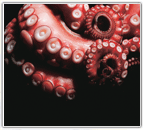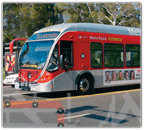01 March, 2003
category: Contactless, Library, Transit
To say that the fare collection system in Hong Kong has been well received would certainly be an understatement. Today, there are actually more Octopus Cards in circulation than there are residents in Hong Kong. Nearly 9 million of the contactless fare collection cards have been issued since the program began in 1997, making it among the largest and the oldest contactless fare collection systems in the world. Cardholders move between ferry, bus, light rail, heavy rail and underground services–provided by nearly 100 different service providers–with the help of the same contactless card.
How it got started
The roots of the Octopus Card stretch all the way back to the early 1980s when the magnetic stripe fare cards used by Hong Kong’s Mass Transit Railway Corporation (MTR) were also put into use by the Kowloon-Canton Railway Corporation (KCRC). Over the next several years, other transit entities also signed on to this precursor to the modern Octopus Card.
In 1993, the MTR began reviewing alternatives to the magnetic stripe cards and the existing system. They concluded that the future of fare collection lay in contactless technologies. To bring the system to life, the MTR, the KCRC, and three other transit companies created a joint venture that could function independently from–but on behalf of–the transit companies that would own it. A private company called Creative Star, owned by the five users of the new fare collection system, was formed.
Joining MTR and KCRC were Kowloon Motor Bus (KMB), Citybus, and the Hong Kong and Yaumati Ferry (HYF). In 2001, the HYF ownership was transferred to two other entities– New World First Bus Limited and New World First Ferry Services Limited. At the same time, the not-for-profit status of Creative Star was changed and it became a for-profit venture. At the start of 2002, the company name was changed from Creative Star to Octopus Cards Limited, to better reflect the brand that had become a household name. Octopus Cards Ltd. employs 128 people to manage and grow the program.
ERG steers the project
Creative Star awarded the project to ERG Group in 1994. ERG, based in Perth, Australia, designed and built the system and continues to provide support to the system’s operator.
The company had been formed ten years prior in 1984 under the name Energy Research Group Australia Ltd. It acquired a fare collection company called Associated Electronic Services Ltd. in 1987, helping to forge the corporate focus on electronic fare collection technology. Today ERG has nearly 900 employees and annual revenues exceeding AUS$120 million (US$72 million). The company has fare collection systems in use in 200 cities around the world including major installation in Berlin, Bordeaux, Gothenburg, Manchester, Melbourne, Rome, San Francisco, Singapore, Sydney, and Toronto.
ERG’s products include a range of ticket/card readers for use in transit stations and vehicles, dispensing machines and kiosks, value adding stations, on-board driver consoles, and portable terminals. They also provide a range of software modules that enable the management and processing of cards and transactions.
It has been nearly a decade since the project began, and ERG continues as the primary technology and service provider to the Octopus system.
Sony provides the cards
The card selected for use in the Octopus system was Sony’s FeliCa IC Card. The 13.56 MHz contactless card does not conform to ISO standards though it is functionally quite similar. In fact, the FeliCa technology was considered for inclusion as a part of ISO 14443 at one time. The card can be read at a distance up to 10 cm and has a reported transaction speed less than 300 ms. As many as 40 cardholders can be moved through turnstiles or gates in a single minute. According to Sony, more than 12 million FeliCa cards were shipped to the Octopus project between 1997 and 2002.
Where is it used?
Each day, more than 7 million transactions are conducted in the system to the tune of HK$48 million (US$6.12 million). Annually, the system processes a staggering HK$17 billion (US$2.2 billion). Active cards average more than one transaction each day. In a report in FinanceAsia magazine, the average balance on an Octopus card was listed at HK$64 (US$8). Applying this figure to the current number of issued cards, there could be as much as HK$576 million (US$74 million) riding on Octopus cards at any given point in time. And each day, an estimated HK$50 million (US$6.4 million) turns over within the system.
With all this money riding on these cards, there needs to be adequate points of acceptance. Indeed in Hong Kong there are. More than 15,000 locations now accept Octopus.
In 2002, Octopus Card Ltd. was authorized by the Hong Kong Monetary Authority as a Deposit Taking Company. This paved the way for the use of Octopus in non-transit locations. That same year, 7-Eleven stores began accepting the card. Today, in addition to the transit points, Octopus can be used at selected fast food restaurants, cafes, grocery/convenience stores, parking lots and meters, vending machines, and public telephones. Currently, 17 banks offer automatic reload capability when a card’s balance dips below an established threshold. Beyond payment, Octopus cards are used for access control in a variety of locations.
Could Octopus mean the end of coins in Hong Kong?
Prior to Octopus, ERG estimates that 60 tons of coins were collected each day from the various transit stations and vehicles–costing transit agencies as much as 0.8% of revenues to cover the coin-handling. Other areas are beginning to see similar benefit. The payment system is expanding in areas that were traditionally the realm of coins and small denomination bills such as vending machines, payphones, and cafes. As these areas continue to expand in the acceptance of Octopus, could the day come when coins are no longer necessary in Hong Kong? Doubtful… But then so was a contactless fare collection system with tentacles reaching into every sector of Hong Kong daily life.



